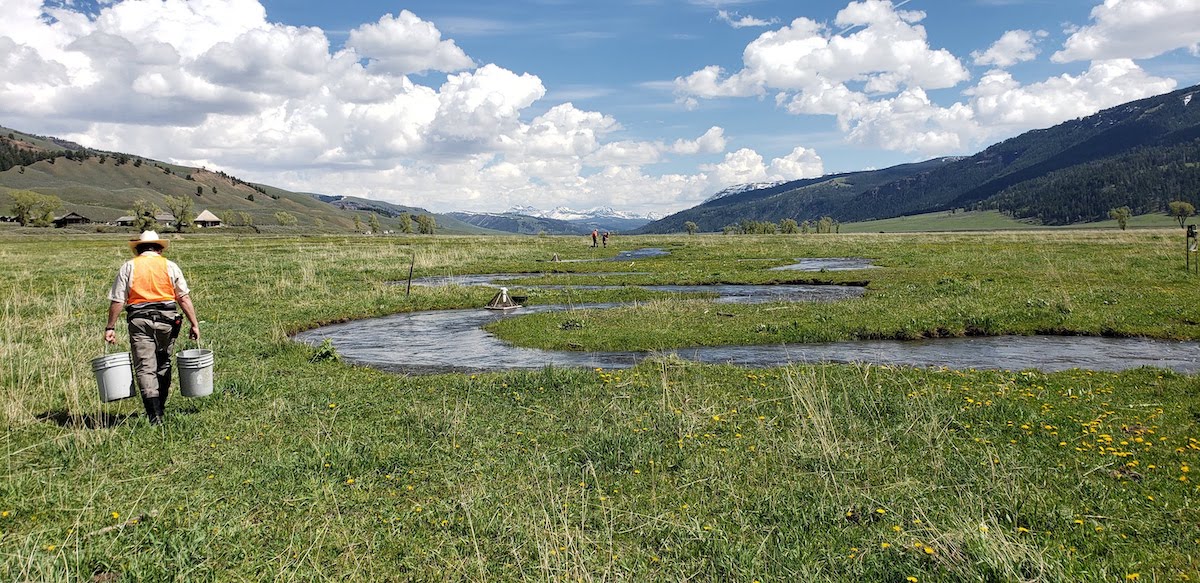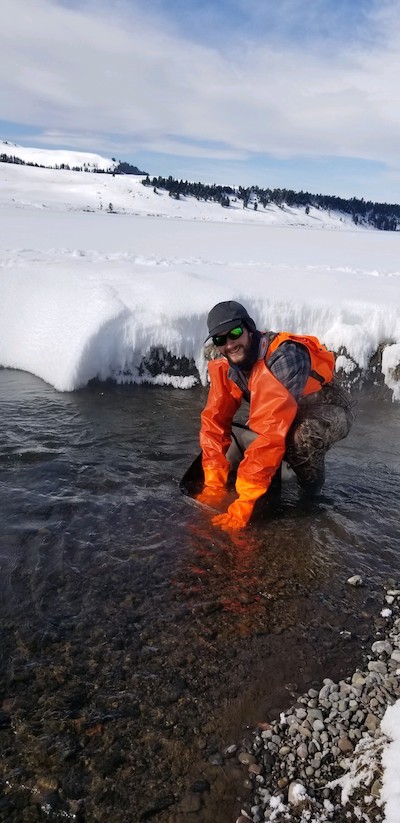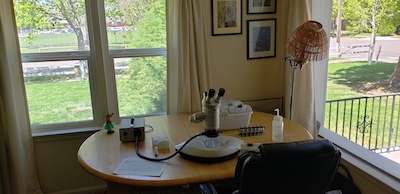ISU doctoral researcher Jeremy Brooks perseveres through disrupted Yellowstone field season
May 12, 2020

POCATELLO – Idaho State University doctoral field researcher Jeremy Brooks was expecting to be out in the wild, open spaces of Yellowstone National Park this spring collecting crucial data for a National Science Foundation study. Instead, for the bulk of the semester he has found himself inside his home using a microscope to examine aquatic insect samples, measuring the teeth of blackfly larvae and the patterns of colorations on the backs of stoneflies.
The coronavirus pandemic has been interrupting university research, including some field research. Brooks’ struggles are an example of some of the challenges researchers are contending with this year.
“Really, the most challenging thing for me has been the uncertainty of not knowing what is going to happen,” Brooks said. “Two months ago I was fully expecting to be out camping and working in Yellowstone right now almost full time, and that changed over the course of the last few weeks. So, now I am kind of sitting here waiting. I’ve basically prepared everything I can so that if they open up the park I am ready to go.”
 Brooks said he has been grateful that he has still had the opportunity to complete important work, despite the postponed field season. Only just recently, in the beginning of May, was he allowed back into the park for a couple of days to conduct some "urgent and time sensitive work" to check on his group’s deployed equipment and to take some rapid samples. His access to the park will continue to be restricted until the park is reopened.
Brooks said he has been grateful that he has still had the opportunity to complete important work, despite the postponed field season. Only just recently, in the beginning of May, was he allowed back into the park for a couple of days to conduct some "urgent and time sensitive work" to check on his group’s deployed equipment and to take some rapid samples. His access to the park will continue to be restricted until the park is reopened.
“We had planned an ambitious field season this year that included work during this spring and early-summer time period, but my study has been pretty significantly interrupted through the closure of Yellowstone National Park, which closed in late March,” Brooks said.
Brooks is part of a collaborative NSF study by ISU and Oregon State University that is studying how the restoration of the predator community in Northern Yellowstone and subsequent changes in woody vegetation around streams, like willow and alder communities, influence stream-riparian food webs and ecosystems. They are investigating how the links between land and water, such as the shading of stream algae by willows or the emergence of aquatic insects, might drive reverberating effects throughout the ecosystem when predators like wolves or grizzly bears are restored.
“Many insects begin their lives in streams but emerge as part of their adult life history and can influence insectivores like spiders, birds and bats,” Brooks said.
Last February, fall and much of the summer, he had completed field work on eight small streams, 3- to 6-meters wide in the park’s Northern Range, where the Lamar River and Soda Butte Creek come together and then flow into the Yellowstone River. This spring and summer’s work was going to complete his field work and it remains to be seen how much of it he’ll be able to complete, contingent on the park reopening.
“We were really keying in on this time frame right now because early spring is a dynamic and important time for streams – the ice is melting off, fish are starting to move around becoming increasingly active and aquatic insects are starting to emerge,” he said. “ Some of the insects that have been overwintering in these streams and growing are now emerging and becoming available to animals like birds and bats.”
This is the time of year when long-distance migratory birds and migratory bats are starting to move back inside Yellowstone, so the researchers are interested in “capturing this moment of early spring arrivals” when there is little food available to them on land and they may be more dependent on emerging aquatic insects.
“We were interested in seeing if there was some type of synchrony, if the timing of the emergence of the insects was important to these migratory insectivores,” Brooks said.
Because he couldn’t work in the park this spring, Brooks has been completing work he had planned to do in the fall after his field work had been completed. The researchers have already collected more than 2,000 samples of stream and terrestrial insects that have to be examined. Brooks was able to bring a microscope home from the ISU Stream Ecology Center and has been starting to process those samples.
“I am in a fortunate position that I can transition to what I am working on now and still make progress on my research,” Brooks said. “I know there are some other graduate students in the biology department that have either just started or haven’t been able to do enough field work yet to really have a laboratory component, so they are in a real bind.”
 He has been going through samples doing some “fine-scale identifying,” determining the genus or species of specific insects, looking at the diversity of the insect communities and estimating the rate at which they grow throughout the year.
He has been going through samples doing some “fine-scale identifying,” determining the genus or species of specific insects, looking at the diversity of the insect communities and estimating the rate at which they grow throughout the year.
Brooks is doing this, keeping an eye on when the park reopens.
“This is a bit of a disappointment for us but it is not the end of the world,” he said. “We are still hoping to get in and do some measurements when and if the park opens, but it is all just a series of contingencies, ‘what-ifs?’ and possibilities to deal with. It is pretty stressful.”
The research picture for graduate students and other researchers is further complicated by cancelled professional meetings and conferences. And graduate students and researchers are dealing with all the other day-to-day, work and outside-of-work challenges caused by the coronavirus pandemic.
“It has been kind of a wild ride we are on, maybe not extreme every day, but you never know what is going to happen. Things are more uncertain than normal,” he said. “Trying to stay sane with all this uncertainty and enjoy the happy moments and persevere through the hard ones, that is really all we can do.”
Middle Photo: Jeremy Brooks collecting samples from Blacktail Deer Creek, Yellowstone National Park prior to the park's closure. (Photo courtesy of Jeremy Brooks, Yellowstone National Park Permit Number YELL-08070)
Categories:
